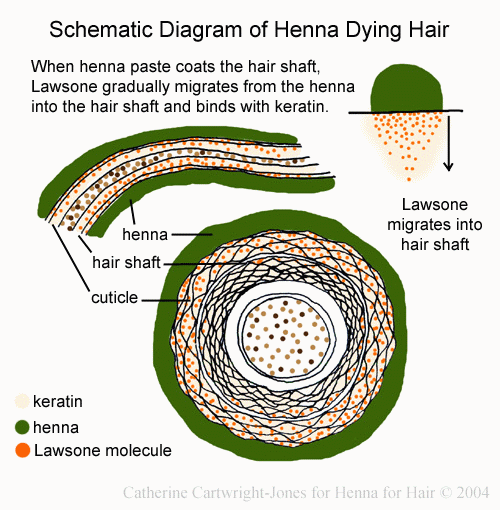Henna: Lawsonia Inermis
How does henna dye
your hair?

| When you
put henna paste on your hair, Lawsone molecules will migrate from the
paste into the cuticle of your hair. The Lawsone precursor molecules are within the plants' cellulostic cell walls, attached to tannin molecular sequences. To make the Lawsone intemediate available, you have to dissolve those cellulose walls, while preserving the hydrogens on the corners of the molecules. The most efficient way to dissolve the cellulose cell walls, while preserving the Lawsone's hydrogen, is to soak them in a mildly acidic liquid for several hours. Consider: if you have a nice crispy salad, and put vinegar on it, and forget to eat it until the next day, the lettuce is going to be disgusting sludge, and not crispy at all. This is because the vinegar dissolved the cellulose. You could also tun your crispy salad to sludge by boiling it. If you boiled henna powder, you would destroy the cellulose, but you would also alter the Lawsone by ripping off the hydrogen molecules on the corners and ruin the ability of the lawsone to bind with the keratin and darken. If you want to know more about dye release and temperature, see: http://www.hennapage.com/henna/how/dyerelease.html When Lawsone migrates from the henna paste into your hair, it saturates the cuticle and binds with the keratin molecules. Lawsone molecules makes the keratin strands stronger, and more resistant to dessication. The longer you leave moist henna paste on your hair, the more Lawsone will migrate into your hair and saturate the cuticle. The more Lawsone your henna has to begin with, the more will be available to migrate into your hair. Ancient Sunrise Twilight henna has much higher dye content than other henna. If you use henna from mehandi.com , you have a better chance of getting a rich color and strong hair! |
 Ancient SunriseŽ Chapter 5 Plants that Dye Hair This chapter discusses henna, indigo, and cassia, (lawsonia inermis, indigofera tinctoria, and cassia obovata) and the chemistry of each of these dye plants. Understanding the botany of these plants will help you understand how to get the best results from your henna hair dye. Links to specific topics in this chapter:
|